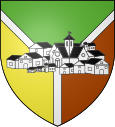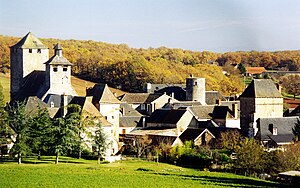Gignac (Lot)
|
Gignac Ginhac |
||
|---|---|---|

|
|
|
| region | Occitania | |
| Department | Lot | |
| Arrondissement | Gourdon | |
| Canton | Martel | |
| Community association | Causses et Vallée de la Dordogne | |
| Coordinates | 45 ° 0 ′ N , 1 ° 27 ′ E | |
| height | 153-356 m | |
| surface | 40.66 km 2 | |
| Residents | 666 (January 1, 2017) | |
| Population density | 16 inhabitants / km 2 | |
| Post Code | 46600 | |
| INSEE code | 46118 | |
| Website | http://www.gignac-en-quercy.fr/ | |
 Gignac - the townscape |
||
Gignac ( Occitan : Ginhac ) is a southern French municipality with 666 inhabitants (as of January 1, 2017) in the Lot department in the Occitania region .
location
The municipality is located in the extreme north of the Quercy and the Lot department near the border with the Corrèze department . It is about 18 kilometers (driving distance) in a south-easterly direction to the canton capital Martel . It consists of several hamlets and individual farmsteads. The formerly independent town of Saint-Bonnet , which was incorporated in the early 19th century , also belongs to the municipality .
Population development
| year | 1962 | 1968 | 1975 | 1982 | 1990 | 1999 | 2006 |
| Residents | 633 | 566 | 527 | 522 | 517 | 562 | 609 |
In the 19th century Gignac regularly had around 1,500 inhabitants; at the beginning of the 20th century there were around 1,000. As a result of the mechanization of agriculture and the resulting loss of jobs, there was a significant population decline in the 20th century.
economy
Gignac was and still is largely characterized by agriculture, with livestock breeding (cattle, pigs, poultry) also playing an important role. Autumn is also truffle time and nuts and chestnuts also play a traditional role in the life of the region. Since the 1960s, tourism has also contributed to the town's income in the form of renting holiday homes and apartments ( gîtes ).
history
The area around today's Gignac was already settled in Roman and Gallo-Roman times. Since the 12th century, the place belonged to the territory of the Vice Counts of Turenne . During the Hundred Years War (1337-1453) the place became depopulated; the men repeatedly fought violent skirmishes with the English. During this time Gignac was fortified and received a defense tower ( donjon ). Even in the course of the Huguenot Wars (1562–1598), the place that remained Catholic was heavily devastated by Protestant units. Due to high debts, the last Viscount de Turenne had to sell his property to the French Crown in 1738 , which sold the vast area to wealthy nobles. Gignac came into the possession of the Dukes of Noailles in 1748 .
Attractions
The parish church of Saint-Martin dates from the 12th, 15th and 18th centuries and has the overall character of a fortified church , to which the watchtower and defensive tower on the east side of the church makes a decisive contribution. A smaller roof attachment rises above the west side, which was added in the 18th century; the Roman archivolt portal is on the south side of the church. The three-aisled interior shows masonry made of quarry stone as well as stone . The apse is closed flat and, like the nave, has a simple Gothic pointed barrel vault . Even without inserted columns, the three apse windows with their sloping reveals look almost classic. The church has been designated as a monument historique since 2004 .
Of the Hôpital de Gignac , which has been known since 1499 , only one chapel remains, which was completely renovated in the 19th century. The hospital previously served primarily to care for pilgrims to Rocamadour and on to Rome .
The church of Saint-Bonnet is also largely Romanesque. The mighty square crossing tower could serve as a bell tower as well as a watchtower and defense tower . The apse is broken polygonally on the outside and shows a - partially figurative - console frieze below the eaves . In the interior of the nave of the structure is Pendentifs worn and developing of an octagon cupola remarkable. A large stone cross rises on a stepped base in front of the church. It is one of around 40 stone or wrought iron crosses found in the municipality. The less significant sights include the stump of a windmill , a spring enclosure, several huts made of dry stone masonry ( cabanes ), etc.
Web links
Individual evidence
- ↑ Église Saint-Martin, Gignac in the Base Mérimée of the French Ministry of Culture (French)




